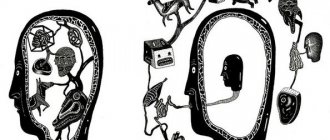Temperament is a stable set of individual mental characteristics, which is based on the type of higher nervous activity of a person. Forms the basis for the development of character traits.
Scientists have tried to determine the type of temperament from ancient times to the present day. The experimental psychologist G. Eysenck's Personality Inventory (EPI) is a classic technique proposed in 1963 based on his two previous tests. The theoretical basis is formed by the concepts of “extraversion”, “introversion” and “neuroticism”, which the author understood as genetically determined characteristics of the central nervous system.
This test is still popular today - due to its simple instructions, accessible processing and the ability to take it online on the Internet quickly and for free.
Hans Jurgen Eysenck is a world-famous scientist who created a test to determine human intelligence quotient - IQ, which is constantly used today.
Predecessor tests
The first temperament questionnaire, the MMQ, was introduced in 1947. It used a single scale as a diagnostic - “neuroticism”. It contained 40 statements with which the person agreed or disagreed. In the course of further research on large samples, the scientist determined that the answers given to the questions of this questionnaire made it possible to identify another measurement scale - “extraversion-introversion”.
Nine years after the first test was published, Eysenck proposed a second personality questionnaire, the MPI, consisting of 48 questions.
During the studies, discrepancies were revealed between the author’s theoretical statements and the data, so scientists and collaborators continued to search for new possibilities that would allow them to determine the type of temperament in accordance with the proposed scales - “neuroticism”, “extraversion and introversion”.
Processing the results
MPI key
Answers that match the key are scored 2 points, “I don’t know” - 1 point, and answers that do not match - 0 points.
| Scale | Direct statements | Converse statements |
| Extroversion - introversion | 2, 3, 6, 9, 13, 21, 32, 40, 42, 43, 47, 51, 52, 55, 60, 70 | 1, 14, 20, 27, 37, 63, 66, 67 |
| Neuroticism | 4, 10, 11, 16, 17, 18, 23, 24, 25, 28, 30, 33, 34, 38, 44, 46, 49, 54, 57, 58, 59, 62, 64, 68 | |
| Lie scale | 5, 12, 19, 29, 35, 39, 56, 65 | 8, 15, 22, 26, 31, 41, 45, 48, 50, 53, 61, 69 |
EPI Key
Answers that match the key are worth 1 point.
| Scale | Direct statements | Converse statements |
| Extroversion - introversion | 1, 3, 8, 10, 13, 17, 22, 25, 27, 39, 44, 46, 49, 53, 56 | 5, 15, 20, 29, 32, 34, 37, 41, 51 |
| Neuroticism | 2, 4, 7, 9, 11, 14, 16, 19, 21, 23, 26, 28, 31, 33, 35, 38, 40, 43, 45, 47, 50, 52, 55, 57 | |
| Lie scale | 6, 24, 36 | 12, 18, 30, 42, 48, 54 |
EPQ key
Answers that match the key are worth 1 point.
| Scale | Direct statements | Converse statements |
| Extroversion - introversion | 1, 5, 10, 15, 18, 26, 34, 38, 42, 50, 54, 58, 62, 65, 70, 74, 77, 81, 90, 92, 96 | 22, 30, 46, 84 |
| Neuroticism | 3, 7, 12, 16, 20, 24, 28, 32, 36, 40, 44, 48, 52, 56, 60, 64, 68, 72, 75, 79, 83, 86, 89, 94, 98 | |
| Psychoticism | 14, 23, 27, 31, 35, 47, 51, 55, 71, 85, 88, 93, 97 | 2, 6, 9, 11, 19, 39, 43, 59, 63, 67, 78, 100 |
| Lie scale | 13, 21, 33, 37, 61, 73, 87, 99 | 4, 8, 17, 25, 29, 41, 45, 49, 53, 57, 66, 69, 76, 80, 82, 91, 95 |
Improved techniques
In 1963, the EPI (Eysenck Personality Inventory) questionnaire was proposed - a new technique, the questions of which, in the amount of 48 pieces, are intended to diagnose the “neuroticism” and “extraversion-introversion” scales, and 9 add up to the “lie” scale - with its help it is determined a person’s desire to “embellish” himself (a total of 57 points were identified).
The EPI methodology was developed based on responses received from more than 30 thousand people, which is several orders of magnitude greater than the number that was involved in the creation of MMQ and MPI.
The test uses two versions with different questions, but identical in form and meaning (to be used twice).
Six years later, Hans and Sibylle Eysenck offer the EPQ, a personality questionnaire that diagnoses not only the previous two described scales and the “lie” scale, but also psychoticism. Its high level is associated with the severity of special conditions in which the presence of inadequate mental reactions (psychosis) is possible. The test involves passing 101 questions.
The name of Eysenck is also known due to the fact that he proposed a method for identifying self-assessment of mental states, during which the presence of a prevailing psychotype is determined - frustration, anxiety, aggressiveness and rigidity.
Currently, the EPQ is not very popular, and not only because the previous test includes 57 questions - almost half as many as the present one. Many foreign researchers argue that the psychoticism scale cannot have a scientific basis, and the results obtained during experiments are often contradictory.
Theoretical basis
G. Eysenck, having analyzed the materials of a survey of 700 neurotic soldiers, came to the conclusion that the entire set of traits that describe a person can be represented through 2 main factors: extraversion (introversion) and neuroticism.
The first of these factors is biopolar and represents a characteristic of a person’s individual psychological make-up, the extreme poles of which correspond to the personality’s orientation either to the world of external objects (extraversion) or to the subjective inner world (introversion). It is generally accepted that extroverts are characterized by sociability, impulsiveness, behavioral flexibility, great initiative (but little persistence) and high social adaptability. Introverts, on the contrary, are characterized by unsociability, isolation, social passivity (with sufficient persistence), a tendency to introspection and difficulties in social adaptation.
The second factor - neuroticism (or neuroticism) - describes a certain property-state that characterizes a person in terms of emotional stability, anxiety, level of self-esteem and possible autonomic disorders. This factor is also bipolar and forms a scale, at one pole of which there are people characterized by extreme stability, maturity and excellent adaptation, and at the other - an extremely nervous, unstable and poorly adapted type. Most people are located between these poles, closer to the middle (according to the normal distribution).
The intersection of these 2 bipolar characteristics allows us to obtain an unexpected and rather interesting result - a fairly clear assignment of a person to one of the four 4 temperaments.
The third factor - psychoticism - was added in the fourth version of the questionnaire and is a characteristic of a tendency towards antisocial behavior and inadequacy of emotional reactions. This factor is not bipolar; its high values may indicate difficulty in social adaptation, although there is no clear justification for the legitimacy of identifying this category, and it is disputed by many foreign researchers.
Description of scales
The “neuroticism” scale describes a certain personal aspect of mental self-regulation. It is based on the concept of emotional stability, which is expressed by adaptive capabilities in everyday and stressful situations, the absence of severe anxiety, vegetative neurosis-like states, and self-doubt. High scores on this scale do not necessarily indicate that a person has neurosis, but they allow it to develop in the presence of prolonged stressful situations. A person in whom this technique allows us to determine a high level of neuroticism will most likely be emotionally unstable, impulsive, lacking self-confidence, irritability, and prone to excessive impressionability and sensitivity. His reactions will not be adequate to the situations that caused them.
Extraversion is a trait that involves focusing on people around you and interacting with them. A typical extrovert is sociable, impulsive, full of optimism, prefers to move forward, and is prone to risk.
Introversion is characteristic of people who are self-absorbed, reserved, and keep a distance from others (with the exception of close people). An introvert does not like to take risks and tries to take a thoughtful approach to making decisions. Keeps impulses under control and is pessimistic.
Eysenck determined that a high score on the “neuroticism” scale is associated with a decrease in the threshold of activation of the limbic system, and “extraversion-introversion” – of the reticular formation.
Interpretation of results uses psychological characteristics located in a coordinate system (the EPQ test uses a three-dimensional scheme, which also includes the “psychoticism” scale). The degree of expression of a particular property is considered. The author believed that the strong and weak types identified by I.P. Pavlov, are close in description to extroverted and introverted. Taking this into account, the classic types of temperament are determined: sanguine (stable and extroverted), phlegmatic (stable and introverted), melancholic (unstable and introverted), choleric (unstable and extroverted).
Thus, the present EPI technique, which allows you to determine the type of temperament, is accessible and easy to determine and interpret the results.
This is interesting
Interesting fact! The studies that formed the basis of the future test were conducted on neurotic soldiers.
Extraversion
- Typical extrovert. Open and sociable, he feels the need to be in society, where he is highly active. Positive emotions predominate, control of feelings is reduced.
- Typical introvert. A closed person with little contact with people who prefers the inner world to the outside world. He loves introspection, which is why he is serious when making decisions, prefers not to take risks. The emotional background is directed towards the negative, but it is very difficult to anger an introvert.
Neuroticism
- Sustainability. Characterized by the ability to adapt to various changes, to achieve one’s goal without reacting to surrounding stimuli. Such a person rarely worries or fears the future. Characterized by reduced emotionality.
- Lability. Poor level of adaptation to change, as well as constant worry and fear. Expressed in rapid mood swings and poor control of feelings. It is easy to lead such a person astray from the intended path.
Classification of temperament types according to Eysenck
The Eysenck test reflects the connection between an individual’s two-phase personality model and a model reflecting the main four types of temperament: choleric, melancholic, sanguine and phlegmatic. This correspondence looks like this:
- A sanguine person ( corresponds to a stable extroverted titan according to Eysenck's classification) is able to adapt to new conditions in the shortest possible time. The emotional experiences of such a person are superficial, affects arise easily and often change. Needs a constant supply of “fresh” impressions and is restless. Sometimes undisciplined, both in everyday life and at work. Monotonous, long work causes severe discomfort and rejection.
- A choleric person (an unstable extrovert according to Eysenck) is easily excitable and impetuous in action. Movements are swift and energetic, affects are clearly expressed. Being carried away by work, they become more exhausted than necessary, because they spend too much energy on their actions. Hot-tempered, irritable, not always able to control his emotions.
- Phlegmatic (stable introvert according to Eysenck's typology) - new forms of behavior are developed slowly, but are very stable. They are slow and sedate in their actions, rarely lose their temper, and are not prone to affective reactions. He is persistent and persistent in his work, does not waste his energy, but approaches the task responsibly and thoroughly. In relationships, he is predictable, stable, and moderately sociable. Depending on the life situation, he will be either constant, thorough and self-possessed, or lethargic, indifferent, weak-willed, unemotional.
- A melancholic person (an unstable introvert in accordance with the same typology) has difficulty concentrating, feelings are deep and stable with weak expression. Intense emotions often cause an inhibition reaction (“give up”). Movements are often slow and speech is quiet. In communication he is shy, reserved, timid. In a calm state he can be a good worker. In an unfavorable situation, he becomes withdrawn, anxious, suspicious and fearful. They are prone to intense internal experiences, and often in circumstances that are not worth such attention.
What does the resulting index mean?
If you passed only one test, write down the number of points you received and the corresponding IQ level that the program gave you and find its value in the table.
| IQ level | % of people | Description |
| less than 20 | 0,20% | People with severe forms of mental retardation. As a rule, they are practically untrainable, cannot take care of themselves and are under constant care. |
| from 21 to 50 | 2% | These are people with a moderate form of dementia. They are unable to learn, but can take care of themselves quite successfully. |
| from 51 to 70 | 7% | Mild form of mental retardation. They can study in special institutions and can successfully take care of themselves. |
| from 71 to 80 | 10% | People with mild mental retardation. Most often, they do not study in special institutions, but graduate from regular schools, albeit with low grades. |
| from 81 to 90 | 10% | Intelligence is below average. These people most often study normally in secondary educational institutions, however, they rarely receive higher education and work in areas related to manual labor. |
| from 91 to 100 | 25% | Average IQ. Such people successfully graduate from school, enter universities, work in average positions not related to science, mathematics, etc. |
| from 101 to 110 | 25% | Average IQ. Such people can graduate from any university and achieve certain heights in science and business in middle management positions. |
| from 111 to 120 | 12% | Above average intelligence. Such people study throughout their lives and, depending on their hard work, can achieve significant heights. |
| from 121 to 130 | 6% | High intelligence. These are people with good mental abilities, as a rule, excellent students at school and college. |
| from 131 to 140 | 3% | Very high intelligence. Extraordinary individuals capable of achieving excellent success in business and science. Outstanding scientists, artists, etc. |
| above 140 | 0,20% | These people are usually called geniuses. They are extremely extraordinary and outstanding personalities; examples include Bill Gates and Steve Hawking. |
Childhood
Hans Jürgen Eysenck (German: Hans Jürgen Eysenck; March 4, 1916, Berlin - September 4, 1997, London) - British scientist-psychologist, one of the leaders of the biological direction in psychology, creator of the factor theory of personality, author of a popular intelligence test, founder of clinical psychology in Britain, the idea of genetic predestination.
His mother, Ruth Werner, shone on silent film screens under the pseudonym Helga Molander, and his father, Anton Edward Eysenck, combined singing and acting. At the age of three, he was left in the care of his maternal grandmother, because his parents separated. At that time he had complete freedom of action, and pranks were treated leniently. Thus, since childhood, Hans was famous for his rebellious behavior, which ultimately led him to success.
In his youth, he was interested in astrology and studied astrological charts in search of patterns that would contribute to the development of talent. He corresponded with many famous astrologers and even compiled charts for some Reichstag representatives, sending them by mail. In these letters he warned of complete collapse, but received no response.
Interpretation of results
MPI
Extraversion:
- from 32 to 48 - “pure” extrovert
- from 16 to 32 - ambivalence, uncertainty
- from 0 to 16 - “pure” introvert
Neuroticism:
- from 32 to 48 - pronounced neuroticism
- from 16 to 32 - average score
- from 0 to 16 - emotional stability
Lie:
- more than 20 - absolute unreliability of the results
- from 16 to 20 - a dubious result
- from 5 to 15 points - reliable result
- 4 points or less - questionable result
EPI
Extraversion:
- over 19 - bright extrovert,
- over 15 - extrovert
- 12 - average value,
- less than 9 - introvert,
- less than 5 - deep introvert.
Neuroticism:
- more than 19 – very high level of neuroticism,
- more than 14 – high level of neuroticism,
- 9 - 13 - average value,
- less than 7 – low level of neuroticism.
Lie:
- more than 4 - insincerity in answers, which also indicates some demonstrative behavior and the subject’s focus on social approval,
- less than 4 is normal.
EPQ
Extraversion:
- more than 15 - “pure” extrovert
- from 7 to 15 - ambivalence, uncertainty
- from 0 to 6 - “pure” introvert
Neuroticism:
- more than 16 - pronounced neuroticism
- from 8 to 16 - average score
- from 0 to 7 - emotional stability
Psychoticism:
- more than 10 - working with people is contraindicated
- from 6 to 10 - there is a tendency towards emotional inadequacy
- from 0 to 5 - absent
Lie:
- more than 10 - unreliable result








